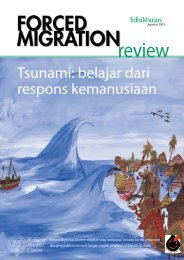FMR 42 full issue pdf - Forced Migration Review
FMR 42 full issue pdf - Forced Migration Review
FMR 42 full issue pdf - Forced Migration Review
Create successful ePaper yourself
Turn your PDF publications into a flip-book with our unique Google optimized e-Paper software.
56 Sexual orientation and gender identity and the protection of forced migrants<br />
<strong>FMR</strong> <strong>42</strong><br />
Further good practice<br />
Because it is frequently difficult to self-identify<br />
openly due to risks of violence or harassment,<br />
LGBTI refugees have sometimes found it useful<br />
to have specific staff members – focal points –<br />
to work with at UNHCR or NGOs. This means<br />
that LGBTI refugees can simply ask at the<br />
reception to speak to the specific staff member<br />
rather than having to explain the nature of<br />
their circumstances and this helps build trust.<br />
Protection of confidentiality is a major concern.<br />
In Kenya, LGBTI refugees cited the presence<br />
of interpreters from their country of origin at<br />
a UNHCR or NGO office as a reason for not<br />
seeking assistance through that organisation,<br />
regardless of whether or not the interpreter<br />
would be in the room during their visit.<br />
Ways to try to address this include posting<br />
information in reception areas regarding<br />
confidentiality of all information in interviews<br />
and in refugee files, as well as incorporating<br />
information on the protection of confidentiality<br />
in outreach materials. Similarly, some NGOs<br />
have provided signs around their offices<br />
such as rainbow flags or posters stating that<br />
refugees will not be discriminated against on<br />
any grounds, including on the basis of sexual<br />
orientation and gender identity. UNHCR<br />
and NGOs should try to provide confidential<br />
spaces where refugees can provide information<br />
discreetly without being overheard. All<br />
staff, including interpreters and additional<br />
staff such as security guards and drivers,<br />
need to be trained on non-discrimination<br />
and the importance of confidentiality.<br />
In Kenya, registration and refugee status<br />
determination can be fast-tracked on<br />
the request of a partner organisation.<br />
However, not all at-risk LGBTI refugees<br />
may be referred by partners. As a result,<br />
UNHCR must have procedures in place to<br />
fast-track vulnerable LGBTI applicants who<br />
approach the office directly for registration<br />
and refugee status determination.<br />
Because LGBTI refugees face high risks of<br />
violence in particular countries or areas,<br />
UNHCR and NGOs need to take steps<br />
to provide protection including through<br />
documenting incidents of violence and<br />
raising concerns about any gaps in police<br />
response with the government, identifying<br />
medical and legal practitioners who can assist<br />
victims, and providing access to safe shelter.<br />
Outreach to police on their duties to protect<br />
all people, including LGBTI refugees, as<br />
well as outreach to refugee communities to<br />
address violence among refugees, including<br />
against LGBTI refugees, are two further<br />
strategies that can help improve protection.<br />
Resettlement countries should continue to<br />
strengthen measures to expedite resettlement<br />
in cases where individuals face high risks.<br />
Resettlement countries should also support<br />
the provision of protection measures such as<br />
safe shelter or transfer to an Emergency Transit<br />
Facility for those facing high risks while they<br />
wait to be resettled.<br />
In 2012, UNHCR in Nairobi worked with<br />
urban partners to assess assistance of groups<br />
with specific needs, including LGBTI refugees,<br />
as informed by UNHCR’s Age, Gender<br />
and Diversity policy of 2011. 5 As a result, it<br />
developed action points to improve aspects such<br />
as identification and outreach, referrals and<br />
case management, and access to information<br />
and services. This is a useful approach and,<br />
if effectively implemented in urban areas as<br />
well as camps and regularly updated, will<br />
help to better mainstream the protection of<br />
vulnerable groups into UNHCR and NGO<br />
protection and assistance programmes.<br />
Duncan Breen BreenD@humanrightsfirst.org is a<br />
Senior Associate in Human Rights First’s Refugee<br />
Protection Program www.humanrightsfirst.org<br />
Yiftach Millo yiftach.hias@gmail.com is a research<br />
consultant for Hebrew Immigrant Aid Society<br />
www.hias.org<br />
1. The Kenyan government announced in December 2012 that<br />
refugees living in urban areas would be relocated to the camps at<br />
Dadaab or Kakuma and that agencies with services in urban areas<br />
should stop assisting refugees and asylum seekers with immediate<br />
effect. For updates and assessment of impact see www.urpn.org<br />
2. Kenya Human Rights Commission The Outlawed Amongst Us<br />
http://tinyurl.com/KHRC-Outlawed<br />
3. 2012 http://tinyurl.com/HRF-Road-to-safety<br />
4. 2012 http://tinyurl.com/HIAS-invisible-in-city<br />
5. www.unhcr.org/4e7757449.html




